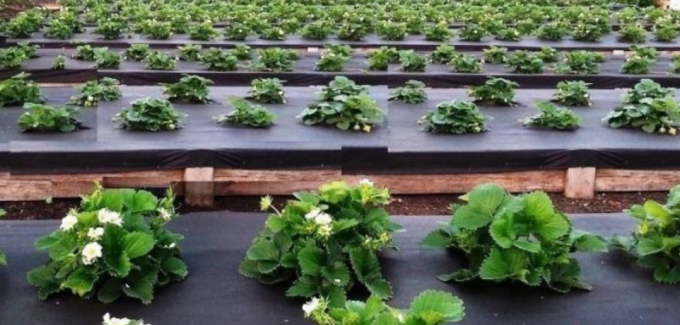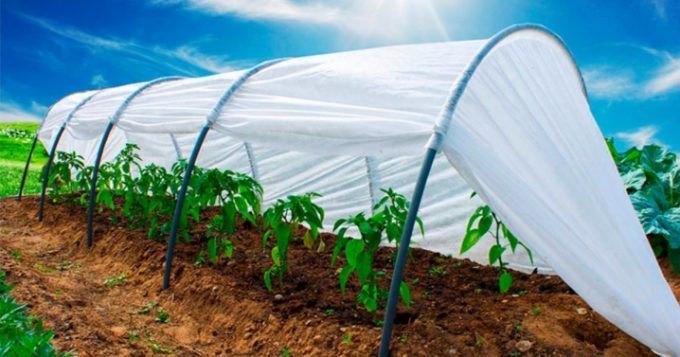У агроволокна нетканая форма в виде ячеек, изготавливается на основе пропилена. Его используют для укрытия грунта и теплиц. Это легкий и достаточно прочный материал, экологически чистый и безвредный. высокая устойчивость к влаге и ультрафиолетовым солнечным лучам, а также он не утрачивает своих качеств под влиянием высоких или низких температур.
В отличие от пленки, агроволокно для растений не требуется снимать с парника днем, чтобы культуры под ним не сварились. Так как этот нетканый материал предотвращает перегрев растений, достаточно просто положить его поверх парника и оставить. Растениям под ним будет тепло, но не жарко и они смогут правильно развиваться
Типы агроволокна
Агроволокно черного цвета используют в качестве мульчи. Его укладывают на заранее подготовленную почву. Под ним не растет сорная трава. Он задерживает влагу в грунте и предупреждает охлаждение почвы. Это облегчает процесс выращивания сельхозрастений. Его обычно используют под грядки с огурцами и клубникой.
Для этой цели агроволкно настилают на прорыхленную почву. В месте высаживания растения проделывается отверстие. В этом случае растение будет получать достаточное количество света и тепла. Агроволокно черного цвета задерживает в почве тепло и влагу. В почве образуется полезные микроорганизмы, а грибковые бактерии и сорная трава не могут развиваться, что облегчает выращивание сельхозкультуры. Этот современный агроматериал — дышащая ткань, и корневая система не испытывает проблем с доступом к кислороду.
Черное агроволокно позволяет поддерживать благоприятную температуру и влажность грунта. Кроме того, при выращивании растений на агроволокне, плоды не соприкасаются с грунтом, поэтому всегда остаются чистыми и практически не поддаются гниению. Это будет особенно актуально при выращивании овощей и ягод на продажу – их предварительно не нужно подготавливать, выращенные на агроволокне они уже имеют привлекательный товарный вид.

Черное агроволокно используется как мульча для растений или укрывной материал. Чаще всего в продаже встречается этот материал плотностью 50-60 г/м². Мульчируют им разные огородные растения, стелют вокруг кустов, деревьев в прикорневой зоне. Черное агроволокно не пропускает свет, поэтому сорняки под ним не растут, при этом материал пропускает тепло, воду. Кроме того, использовать агроволокно можно и для обустройства красивых дорожек, бордюров. Его укладывают в выкопанные траншеи и затем засыпают декоративным камнем или землей, песком. В итоге получается аккуратный бордюр, на котором не будут расти сорняки, так как черный материал не позволит им прорасти.
Агроволокно черное, избавляет от сорняков и необходимости обрабатывать участок гербицидами для борьбы с вредными растениями. Поэтому овощи и ягоды, выращенные на агроволокне, являются экологичными и безопасными для здоровья. Черное агроволокно также позволяет существенно экономить время в уходе з участком, так как потребность пропалывать грядки отпадает.
Агроволокно белого цвета отличается от черного цвета своей функцией. Этот настил пропускает воду, тепло и свет, и воздух, создавая парниковый эффект, что ускоряет процесс выращивания и сокращает время от высадки до получения урожая.
Использование белого полотна препятствует образованию конденсата в теплице, что создает в ней хороший микроклимат. Этот материал изготовляется разной толщины, что может влиять на предупреждение проблем от разных температур. Более толстое волокно может защитить от более низкой температуры. Такой вид агроволокна используют только для укрытия теплиц и парников. Его также можно сочетать с обычного вида мульчи.
Многие огородники путают агроволокно и агроткань. Но это разные материалы. Агроткань имеет более высокую плотность – это тканный материал, а агроволокно – не тканный.
Белое агроволокно плотностью от 17 до 23 г/м2
Это тонкое агроволокно, хорошо пропускающее солнечный свет (примерно 80%), воздух и влагу. Его не натягивают на дуги, а укладывают непосредственно на почву. Применяют такое укрытие после посева семян в грунт, при этом неважно, овощные ли это культуры, цветы или газон.
Почва, укрытая тонким агроволокном, сохранит тепло и необходимую влагу, благодаря чему всходы появятся быстрее и будут более дружными. Зеленцы по мере роста смогут приподнимать волокно, ведь оно тонкое и почти невесомое, поэтому нет необходимости снимать его сразу после появления ростков.
Пока растения не окрепнут, они будут надёжно защищены и от солнца, и от ветра, и от птиц, и от насекомых-вредителей. Агроволокно толщиной 23 г/м2 сможет защитить посевы и от возвратных заморозков.
Положительная характеристика агроволокна
Потребителю материал известен как спанбонд, лутрасил, агрил и агротекстиль. Агроволокно бывает разной плотности — от 15 до 120 г / м2, и, в зависимости от этого, имеет различное назначение. Плотность — один из важнейших параметров, которые нужно учитывать при выборе материала.

В чем различия?
Спанбонд — наименьшей плотности (17-23 г / м2) хорошо пропускает свет, очень легкий. Его можно использовать для укрытия без дуг, потому что материал не создает нагрузки даже на молодые всходы. Подобное укрытие может защитить растения от заморозков 0-5 ° С.
Агроволокно для грядок средней плотности (30-42 г / м2) используется для накрытия каркасов парников и теплиц. Может защитить растения от заморозков до 6-8 ° С, при угрозе серьезного понижения температуры рекомендуется делать дополнительное укрытие.
Плотное агроволокно — 60 г / м2 — используется для защиты молодых деревьев и кустов в зимний период. Можно также использовать этот вид укрывного материала для теплиц и парников, защиты от заморозков.
Агротекстиль для парников выпускают только белого цвета, аналогичный материал черного цвета, в основном, применяется для мульчирования. Следует всегда обращать внимание на качество нетканого материала, ведь агроволокно для грядок хорошего качества может прослужить вам с десяток лет, а некачественный материал испортится уже в первый год использования.
Преимущества агроволокна заключается в следующем:
- пропускает влагу и воздух;
- предупреждает рост сорной травы;
- способствует защите растений от насекомых и птиц;
- обеспечивает естественный процесс развития растений;
- предупреждает образование корки на поверхности грунта;
- снижает количество прополок и рыхлений;
- повышает температуру почвы и защищает от резких изменений температуры;
- предупреждает перегревание растений в жаркий период.
Такие уникальные свойства агроволокна позволяют его использовать в разных обстоятельствах. Время использования волокна может колебаться от 2 до 5 лет.
Заключительная часть
Использование в сельском хозяйстве агроволокна помогает снизить затраты труда на выращивание растений. Как основой недостаток — сравнительно высокая стоимость материала. Однако, если учесть то, что его можно использовать несколько раз, то его стоимость полностью оправдывается за несколько сезонов.
Для ускорения развития и созревания растений используют парники, покрытые агроволокном. Уже при первом сборе урожая можно увидеть эффект от использования этого материала.
Материал ценится за свою экологичность, легкость и одновременно прочность. Опыт подтвердил то, что от использования лутрасила, растения в теплице всходили и развивались с хорошими показателями. Данное укрытие поддерживает влажность, тепло на нужной планке. Он защищает посевы от птиц, насекомых, а воздуху и солнечным лучам позволяет проходить к растениям в должной мере.
Структура волокна обработана специальным методом, который не позволяет внутрь парника проникать высокому количеству ультрафиолета. Если всходы накрыты пленкой, то во время жары, ее приходится убирать, чтобы заходил свежий воздух и всходы не погибли. При использования агроволокна такой проблемы нет – растения не перегреваются.












